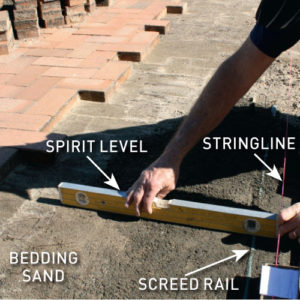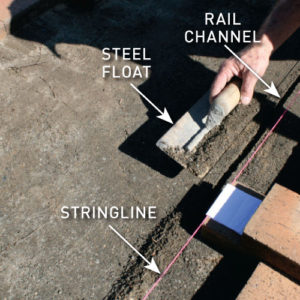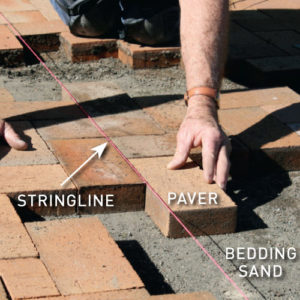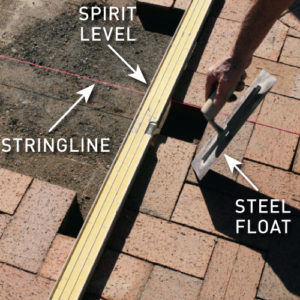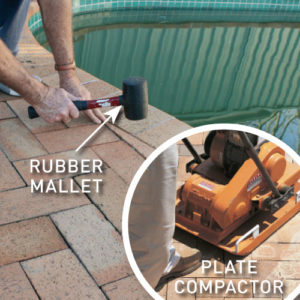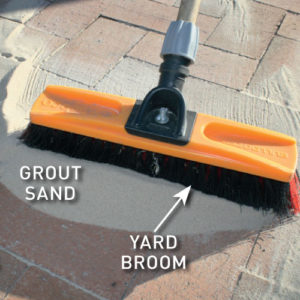How To Repair Pool Pavers

Fix sunken and lifted pavers to save money and eliminate trip hazards on a wet surface.
A swimming pool is the source of hours of family fun and lots of splashes. But often, it’s this water splashing over the paved pool surround that can lead to sinkage.
The underlying cause of the sinkage can stem from a sub-grade that’s not solid or hasn’t been compacted properly, the incorrect use of bedding sand, or washout caused by a lack of stable edging.
This pool was installed in 2004 with a bullnose clay coping mortared onto a concrete edge beam and surrounded with matching clay pavers laid in a herringbone pattern.
In the last decade, the compacted sub-grade of roadbase had settled, showing as sinkage in the paving.
Lifting the entire paved area and adding a concrete sub-grade is one solution but comes at a great cost.
Instead, we lifted the affected areas and re-screeded with stabilised bedding sand, then relaid the pavers. This repaired the problem in just a weekend at little expense.
Essential supplies
To repair paving DIY, you need a few basic tools and materials.
SAND to bed the pavers. For this area, 100kg was needed, costing $10.
CEMENT to mix with the bedding sand in a 5:1 ratio to stabilise it and make it more resistant to sinkage. One 20kg bag, about $10, was used here.
GROUT for paving the area, either sand or a sand-and-cement mix. We used Pave Set, a blend of sand and gelling agents that inhibits weeds and insects, with four bags costing $56 in total.
ANGLE GRINDER to cut pavers to size. For big jobs, you can hire a brick saw for about $110 for 24 hours.
SPIRIT LEVEL for setting fall in bedding sand and screeding.
STEEL FLOAT for screeding bedding sand.
YARD BROOM to spread the grout sand.
Choosing sand
BEDDING SAND is coarse-grained and easily screeded, and is often called packing or paving sand. It can be up to 5mm in diameter and is the leftover fines of crushed rocks, or natural sand such as washed river sand. The availability will vary with your location.
GROUT SAND is either a mix of fine sand and cement in a 6:1 ratio or just fine-grained beach sand. The dry mix is swept into the joints and the surface hosed well but lightly to prevent stains. Once the mix sets, there is less water penetration and weed growth.
Fencing the pool
Protecting your family this summer is as simple as ensuring your pool is adequately fenced. Pool fencing can be installed DIY, with attractive aluminium or glass options to suit modern backyards.
Drowning is the leading cause of preventable death for kids under five, and for every death, Royal Life Saving (RLS) estimates another three kids end up in hospital after near-drowning incidents in home pools.
Fit gates with child-safe latches and do regular maintenance checks to make sure the fence stays in good condition.
Relay the pavers
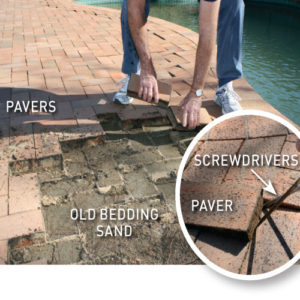
Carefully prise out one paver using two flat drive screwdrivers. Continue lifting pavers to the width and length required and set aside.TIP Lift and then repair about 3sqm of paving at a time.

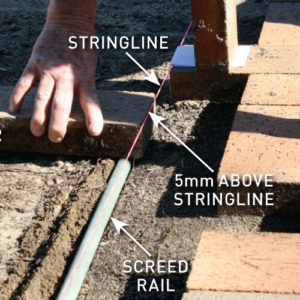
Set a taut stringline across the area to be screeded at the finished paving height. Bed a screed rail below the stringline by the thickness of a paver, with the paver 5mm above the stringline to allow for compaction.
